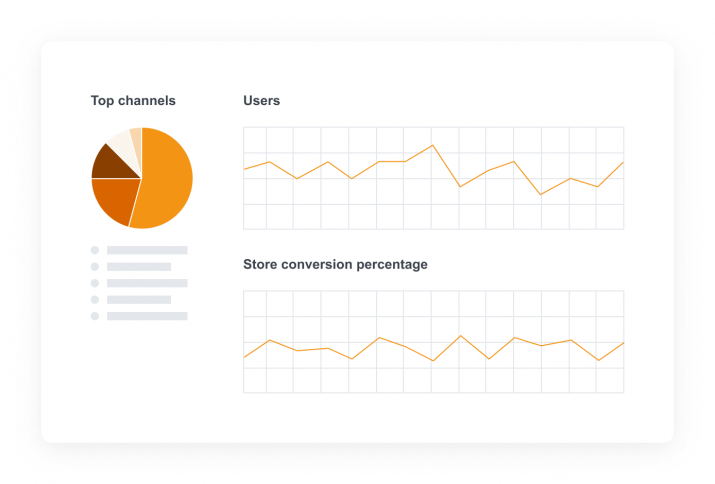Online stores have been popping up this year at an exhilarating rate. However, setting up one is really a fraction of the work. You also need to make your online store convert. So how to increase the traffic of your eCommerce and get conversions?
Generating traffic
After you’ve set up a webshop, you need ways to create traffic to your store. There are many obvious, great ways to do this. A resourceful eCommerce owner utilizes a good mix of all of these to create a decent amount of traffic to their online store.
Social media toots your horn
It’s vital for your eCommerce to make sure you’re visible in the social media channels where your target audience is. There are many options, and in addition to the good ol’ Facebook, Instagram is definitely the place to be these days. Also, advertising on YouTube is worthwhile. Online stores that sell goods aimed at Gen Z might even consider being present in TikTok.
Paid ads are worth it
Utilizing paid advertising is something that a modern eCommerce owner should do. Different types of Google Ads or Facebook ads are a big help in creating traffic to your store’s normal selection but especially for special campaigns.
Campaign ads can be directed to landing pages that have the campaign outlook and more information about the campaign – with direct links to your webshop.
Add a sense of urgency to your campaign ads with discount expiry dates and times, or amount of products available. Examples:
“-20% from the entire selection – only until Sunday!”
“Act fast! Limited batch!”
Make sure you ad copy is on point and descriptive of what you're offering.
Landing pages land the deals
As said, landing pages are a great way to direct traffic to your webshop. A good landing page effectively guides a potential customer through the buying process.
A landing page is relatively light in structure and perhaps more flexible to implement than a page on your main website. This type of page makes it easier for the visitor to be gently guided towards the desired action, for example, end up on a specific product page or fill out a form.
Keep in mind the basic rule of thumb: a short landing page produces more leads in terms of quantity, a longer landing page produces better leads in terms of quality.
Make your audience speak for you
User-generated content (UGC) is something that you should consider utilizing early on. Nothing is as convincing as real people recommending your products or services in their own content. It is incredibly credible free promotion. Especially small online shops should make use of this type of advertising.
Search engine optimized stores take the cake
As we point out in eCommerce guide – which you can download for free at the end of this article – 44% of people start their online shopping journey with a Google search (nChannel).
Therefore, you need to have solid SEO game or it’s game over.
Fighting for organic visibility requires great search engine optimization and long-tail descriptions featuring your main keywords. Meaning: if you sell unicorn onesies, use long-tail descriptions such as “cute unicorn onesies for kids”.
Making your store convert
After you have sufficient traffic, you will want to make your store as conversion-optimized as possible. There are many ways to succeed in this but first we need to do a little bit of maths. Don’t worry, this is easy as 1, 2, 3.
Calculate why conversion optimization matters
Globally the average eCommerce conversion rate is around 2,5%. Conversion rate is calculated by dividing the number of conversions within a time period with the number of visitors or those that have seen your ad, for example.
Conversion optimization can help you make cold hard cash by optimizing the functionality of your store. Here’s a simple calculation about what conversion optimization can do for your store:
Visitors x conversion rate x average purchase
5000 x 1 x 150
Sales are 7500.
Imagine ramping up sales with just 0,1% addition to conversion rate.
Data is king
Conversion optimization cannot really be done before you know what you’re doing in the first place. Measure and monitor everything you possibly can and then test out other possibilities to do things.

Monitoring what’s happening in your eCommerce is vital in conversion optimization.
Measure and monitor how these are working in your eCommerce:
- Customer segments
- Buyer journey
- Call-to-action buttons
- Shopping cart steps
Investigating the data you get from your store is an ongoing process. If you want to get to the bottom of shopping cart abandonment, for example, you should pay attention to what devices are being used, at what stage the abandonment happens, and carry out A/B testing to improve the situation. However, test one aspect of your store at a time so that you can be sure your findings are correct.
One-page shopping cart for the win
Consumers’ tolerance for complicated shopping experiences is slim to none. People rather abandon their shopping cart on a whim than fill out a two-page form.
The most important aspect of online shopping is that the buying process is easy and smooth. This was rated as even more important than free shipping and discount campaigns when asked from consumers. And we know how people usually love when something is free or discounted.
We have all encountered many different kinds of experiences while shopping online and there truly is a wide variety of them out there – one-page shopping carts that seem to work telepathically to tedious forms page after page resulting in a frustrated customer who just sighs and hits the exit button.
Let your products do the talking
Having a selection that is easy to browse and that is logically organized makes you stand out in a positive way. There is a herd of stores out there that really don’t have filtering options that would make sense.
Also, having different variations, such as color options, inside one product page and not as separate products really makes things easier for the customer. With LianaCommerce, it’s easy to filter huge product lists with a vast number of properties.
Offer a variety of payment options
You increase your eCommerce’s chances of converting when you offer a wide range of payment options that the customer can choose from. Payment options that you should consider having:
- Credit cards, like Visa, Mastercard, American Express
- Debit cards
- Online banking
- PayPal
- Invoicing
- Installment payment plans (depending on location, such as Klarna or Collector)
Make security a priority
With identity thefts and stolen credit card numbers, you really need to make sure that your customers’ personal information is safe when they are making purchases in your online store.
SSL certificate indicates to users that the site they are visiting is properly protected. SSL also slightly improves the store’s search engine visibility and, for example, Google favours safe sites in its search results.
The price is right?
Make sure your pricing is on point. For this, you need to know the value of your product and not sell yourself short. However, you need to monitor the competition and stay alert for dropping prices in a product category or an individual product.
Want to learn more about eCommerce?
Helping your online store to get conversions is not rocket science but still requires a bit of effort. Make sure that you have many channels from which you get traffic and then have conversion optimization taken care of in your store. The deals will be dropping! Learn more about eCommerce and download our guide from the button below.





Comment
Comments
No comments